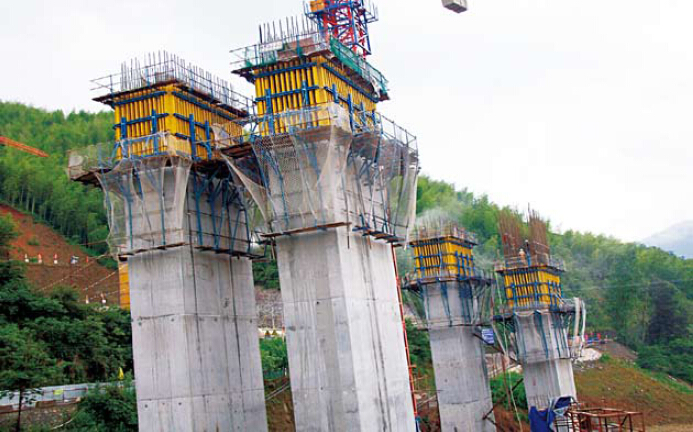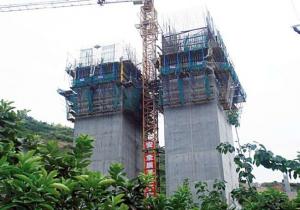Climbing Bracket for Formwork and Scaffolding System
- Loading Port:
- Tianjin
- Payment Terms:
- TT OR LC
- Min Order Qty:
- 50 m²
- Supply Capability:
- 1000 m²/month
OKorder Service Pledge
OKorder Financial Service
You Might Also Like
Climbing Bracket CB240 & CB210
They are framework brackets for supporting large-area wall formwork.
Typical applications for the CB240&CB210 are pier and column/shear wall/core walll/ in the
building.
CB210 has smaller size than CB240, it will be cost effective in some condition.
Characteristics:
◆ High bearing capacity
The high loading capacity of the brackets allow very large scaffold units. This saves the number
anchor points required as well as reducing climbing times.
◆ Simple moving procedure by crane
Through the strong connection of formwork together with the climbing scaffold, both can be moved
as a single climbing unit by crane. Thus valuable time-savings can be achieved.
◆ Fast striking process without a crane
With the retrusive set, large formwork elements can also be retracted quickly and a minimum of
effort.
◆ Safe with work platform
The platforms have assembled firmly with bracket and will be climbing together, without scaffolding
but can work safely in spite of your high location.


- Q:What is the difference between the steel template and the assembled steel template?
- Why do you think I would like to set up a template for artificial labor costs higher than the stereotypes of the general template workers are square but the combination of the template construction is more difficult to be expensive so normal
- Q:How does steel formwork contribute to the strength of the structure?
- Steel formwork contributes to the strength of a structure by providing a rigid framework that supports the concrete during the pouring and curing process. This ensures that the concrete is evenly distributed and properly shaped, resulting in a more durable and structurally sound building. The steel formwork also helps prevent any deformation or collapse of the structure under the weight and pressure of the concrete, ultimately enhancing its overall strength and stability.
- Q:How does steel formwork affect the overall cost-effectiveness of a construction project?
- Steel formwork can significantly enhance the cost-effectiveness of a construction project due to its durability and reusability. Its strength allows for multiple reuses, reducing the need for frequent replacements and thereby decreasing material and labor costs. Moreover, steel formwork facilitates faster construction processes, minimizing labor expenses and project duration. Additionally, its higher quality finish reduces the need for additional finishing work, resulting in further cost savings. Overall, steel formwork's longevity, efficiency, and reduced maintenance costs make it a cost-effective choice for construction projects.
- Q:How does steel formwork handle formwork removal and storage?
- Steel formwork is known for its durability and strength, making it ideal for handling formwork removal and storage. After the concrete has cured, the steel formwork can be easily removed by dismantling the panels or frames. The components can then be cleaned, inspected, and prepared for storage or reuse. Due to their robust nature, steel formwork systems can withstand multiple uses, allowing for efficient storage and future construction projects.
- Q:Can steel formwork be used for structures with high chemical resistance requirements?
- No, steel formwork is not suitable for structures with high chemical resistance requirements as steel is prone to corrosion and may react with chemicals, compromising the integrity of the structure. Alternative materials, such as chemically resistant plastics or specialized coatings, would be more appropriate in such cases.
- Q:What are the different types of accessories used in steel formwork systems?
- Steel formwork systems commonly utilize a variety of accessories to enhance support, stability, and usability during construction. One such accessory is the formwork prop, also called a shore or post, which is adjustable in height and provides vertical support for formwork panels or beams, effectively distributing the weight of the concrete. Another frequently employed accessory in steel formwork systems is the formwork beam, which horizontally supports formwork panels while adding strength and stability. Depending on project requirements, these beams can be made of steel or aluminum. Formwork clamps play a crucial role in steel formwork systems, ensuring secure connections between formwork panels or beams. Available in different sizes and designs, these clamps securely hold the formwork in place and accommodate various formwork configurations. Tie rods and wing nuts are also commonly used accessories, tightly securing formwork panels and preventing any gaps or leaks. By inserting tie rods through panel holes and tightening with wing nuts, a strong and secure connection is established. Furthermore, formwork brackets and supports are utilized to reinforce the formwork system and provide additional stability. These accessories are typically attached to the structure or scaffolding to hold the formwork securely. Other accessories, including formwork corners, wedges, and spacers, contribute to accurate and precise formwork placement and alignment. Overall, the diverse range of accessories employed in steel formwork systems serve multiple purposes, such as support, connection, reinforcement, and alignment. These accessories are crucial in creating a robust and dependable formwork system capable of withstanding the pressures and forces experienced during the concrete pouring process.
- Q:How does steel formwork perform in high-temperature conditions?
- Steel formwork performs well in high-temperature conditions due to its high melting point and excellent heat resistance. It retains its structural integrity and stability, making it a reliable choice for construction projects in such environments.
- Q:Can steel formwork be used for both straight and curved walls?
- Yes, steel formwork can be used for both straight and curved walls.
- Q:Can steel formwork be used for both small-scale and large-scale projects?
- Steel formwork is suitable for both small-scale and large-scale projects. It is highly adaptable and can easily be tailored to fit different project sizes and requirements. With its exceptional strength and durability, steel formwork is ideal for large-scale projects involving heavy concrete structures. Moreover, it can be reused multiple times, making it a cost-effective option for projects of any size. Its inflexible structure guarantees precise concrete placement, which is crucial for achieving top-notch results in any project. Therefore, whether it's a small-scale residential construction or a large-scale commercial development, steel formwork is a dependable choice for the successful implementation of concrete works.
- Q:Can steel formwork be used for both symmetrical and asymmetrical concrete elements?
- Steel formwork can be utilized for both symmetrical and asymmetrical concrete elements, rendering it highly adaptable and capable of meeting the specific needs of any concrete structure, regardless of its shape or intricacy. It possesses the advantage of easy adjustability, facilitating the creation of both symmetrical and asymmetrical shapes. Furthermore, steel formwork offers exceptional strength and durability, guaranteeing its ability to withstand the pressure exerted by the concrete throughout the pouring and curing process. As a result, it proves to be a fitting choice for an extensive array of concrete elements, encompassing walls, columns, beams, slabs, and beyond.
1. Manufacturer Overview |
|
|---|---|
| Location | |
| Year Established | |
| Annual Output Value | |
| Main Markets | |
| Company Certifications | |
2. Manufacturer Certificates |
|
|---|---|
| a) Certification Name | |
| Range | |
| Reference | |
| Validity Period | |
3. Manufacturer Capability |
|
|---|---|
| a)Trade Capacity | |
| Nearest Port | |
| Export Percentage | |
| No.of Employees in Trade Department | |
| Language Spoken: | |
| b)Factory Information | |
| Factory Size: | |
| No. of Production Lines | |
| Contract Manufacturing | |
| Product Price Range | |
Send your message to us
Climbing Bracket for Formwork and Scaffolding System
- Loading Port:
- Tianjin
- Payment Terms:
- TT OR LC
- Min Order Qty:
- 50 m²
- Supply Capability:
- 1000 m²/month
OKorder Service Pledge
OKorder Financial Service
Similar products
New products
Hot products























